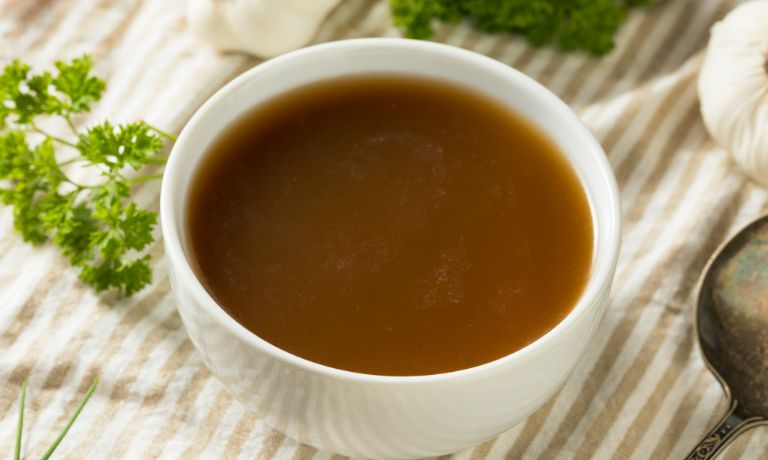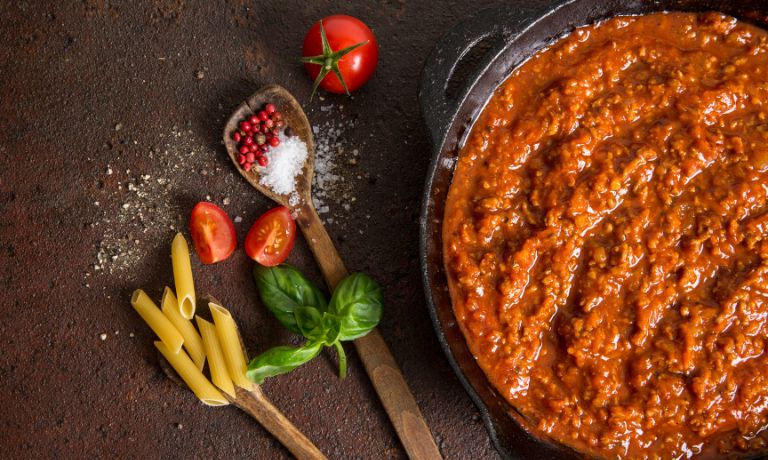Cooking with red wine can be a great way to create delicious, complex flavors in dishes such as bolognese.
But what about those who don’t want the alcohol content or simply are out of it?
Is there a suitable substitute for red wine in bolognese that won’t affect the taste of your recipe?
Fortunately, some excellent substitute options for red wine can add depth and richness to your dish while still allowing you to enjoy all its classic flavors.
In this blog post, we will explore several alternatives so you can make sure your bolognese is just as tasty without compromising quality.
What Is Bolognese?
Bolognese, or ragù alla Bolognese, is a meat-based sauce from Bologna, Italy.
It is a slow-cooked sauce typically containing ground beef, onion, celery, carrot, pancetta (or bacon), tomatoes and red wine.
The meats are usually browned in butter and cooked together until the sauce has thickened and all of the flavors have melded together.
Bolognese is usually served with various kinds of pasta, such as spaghetti, tagliatelle or pappardelle, but it can also be used to make lasagna or other baked dishes.
It is one of the most popular sauces in Italian cuisine and is widely enjoyed worldwide.

Substitutes For Red Wine In Bolognese
If you don’t have red wine on hand for your Bolognese sauce, several alternatives will work as well.
These substitutes may also add a unique flavor to the dish.
Beef Broth
Beef broth is a liquid made from simmering beef bones, vegetables, herbs, and spices in water for several hours.
The resulting liquid can be used as a flavorful base for many dishes or enjoyed independently.
It has a deep, rich flavor, making it an ideal meat-based alternative to traditional red wine when making Bolognese sauce.
To substitute for red wine in bolognese, replace the same amount of red wine with an equal amount of beef broth and let it cook until reduced to the desired consistency.
The resulting sauce will have a subtly meaty flavor that adds complexity and depth to this classic Italian dish.
Additionally, beef broth, as a substitute for red wine, is a great way to add extra protein and nutrients to your meal without sacrificing flavor.

Ginger Beer
Ginger Beer is an alcoholic beverage made from a fermented mix of ginger, sugar, and spices.
It has a slightly sweet and spicy flavor with a slight hint of carbonation.
In Bolognese, Ginger Beer adds flavor to the traditional tomato sauce.
The combination of the sweetness from the beer and the spiciness from the ginger gives the dish an unexpected depth of flavor.
It can also be used to create a unique spritz for cocktails or as a beverage.
Whether you want to make your Bolognese sauce or use it as an ingredient to add some zip to classic drinks, Ginger Beer will surely add something special.

Sherry
Sherry is a fortified wine, usually originating from the Jerez region of Spain.
It’s made with a mixture of white grapes and aged in oak barrels.
Sherry can range in color from pale yellow to deep amber, depending on how long it has been aged.
Sherry is used frequently in Bolognese cooking as an ingredient for sauces and stews, such as the classic Bolognese Sauce.
Its unique flavor adds depth and complexity that can’t be achieved with any other ingredient.
The nutty, fruity flavor of sherry provides an ideal balance to the rich flavors in classic Bolognese dishes.
It adds body and richness to lighter sauces, such as cream-based ones.

Brandy
Brandy is a distilled spirit made from the fermented juice of grapes.
It has a strong, distinct flavor and aroma, making it an excellent substitute for red wine in many dishes, including Bolognese sauce.
When used in place of wine, brandy adds a rich sweetness and depth to the dish that can’t be achieved with other ingredients.
The flavor of brandy also helps to bring out the other flavors in the dish, creating a balanced and well-rounded meal.
Brandy can be added directly to the sauce or used as an ingredient when making the Bolognese.
When using it to finish the dish, a splash of brandy just before serving adds an elegant touch that elevates the final product.

Cranberry Juice
Cranberry juice is a tart, pink-colored beverage made from cranberries.
It has a sweet and tart flavor and is often used as an ingredient in recipes or enjoyed on its own.
Cranberry juice is high in antioxidants and other nutrients that may help protect the body against certain diseases.
Cranberry juice can substitute for red wine in Bolognese sauce to provide a unique flavor combination with tomatoes, onions, and other ingredients.
It adds a sweet-tart zing that enhances the flavors of the sauce.
The acidity also helps cut through the fat in the meat, creating a more balanced dish.

Vinegar
Vinegar is an acidic liquid produced from the fermentation of ethanol.
It is commonly used as a condiment and preservative in various cuisines worldwide, including Bolognese.
In Bolognese, vinegar is usually used to add a tangy flavor and bring out the natural sweetness of the ingredients.
Vinegar can also help balance out the flavor of the dish by cutting through overly rich flavors and adding a subtle zest.
Additionally, vinegar can be used as an excellent natural tenderizer for tougher cuts of meat, making them more tender and juicy after cooking.
Vinegar also helps preserve food, so it’s commonly used to pickle or marinate vegetables before adding them to Bolognese sauce.

Port Wine
Port Wine is a type of fortified wine traditionally used in the Italian city of Bologna for centuries.
It is often added to sauces like Bolognese, where it lends its rich and sweet flavor and deep ruby hue.
Port Wine also helps balance the savory flavors of meat and vegetables in traditional Bolognese dishes.
Since it is a fortified wine, its alcohol content can add richness and depth to most dishes.
However, Port Wine should always be added in moderation, as too much can make the sauce overly sweet or overpower the other flavors.

Peach Nectar
Peach nectar is a fruit juice blended and concentrated to create a syrupy liquid.
It is exceptionally sweet, with a peachy flavor that can be used for many different recipes.
In Bolognese, peach nectar adds sweetness to the dish and helps balance the richness of the ground meat and other ingredients.
The nectar also adds a unique flavor to the sauce, bringing out the flavors of the other ingredients.
It is typically used in small amounts and added towards the end of the cooking process.
When adding peach nectar to Bolognese, remember to taste as you go so that you don’t over-sweeten or overpower other flavors.

FAQs
Is Red Wine Necessary For Making Bolognese Sauce?
No, red wine is not necessary for making bolognese sauce.
Depending on your recipe, white wine can be substituted for red wine or omitted altogether.
If you include it in your bolognese sauce recipe, either type of wine will lend a deeper flavor and depth to the dish.
Can Balsamic Vinegar Be Substituted For Red Wine In Bolognese Sauce?
Yes, you can use balsamic vinegar as a substitute for red wine in Bolognese sauce.
However, balsamic vinegar has a more acidic flavor than red wine, so you may need to adjust the other ingredients.
Should Milk Be Included In Bolognese Sauce?
While it is a common practice to add milk to bolognese sauce, it is not essential.
Milk can be used as a substitute for cream or add richness and creaminess to the sauce.
Conclusion
Many different ingredients can be used as a substitute for red wine in Bolognese sauce, each with its unique flavor and contribution to the dish.
Sherry, brandy, vinegar, port wine, cranberry juice, and peach nectar are excellent substitutes for red wine in Bolognese sauce.
Each ingredient will add a unique flavor to the dish that will surely add something special.
Be sure to taste as you go and adjust the other ingredients in your recipe to get the desired flavor profile.


